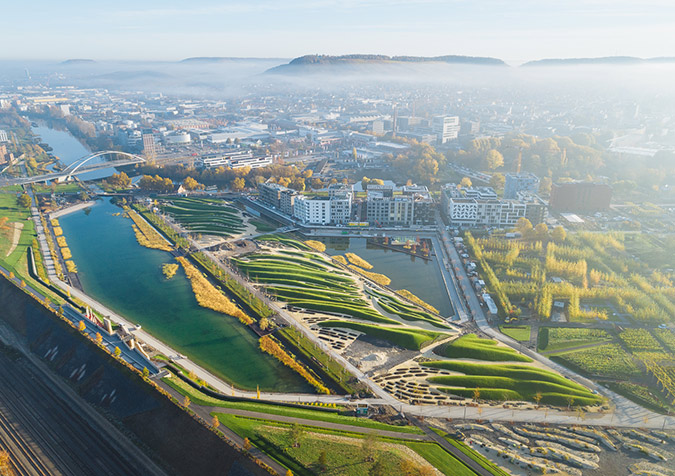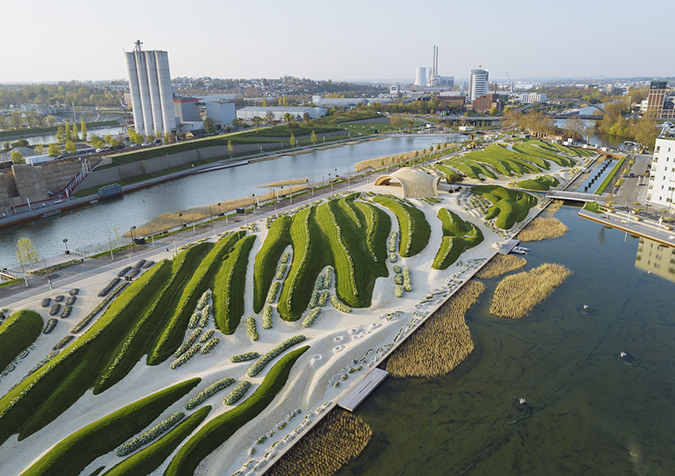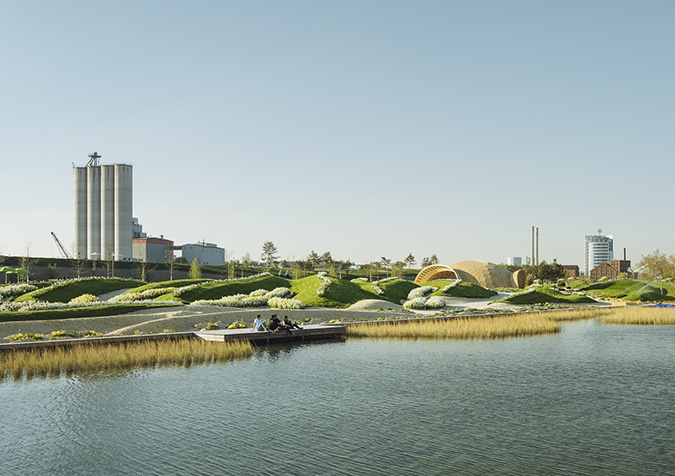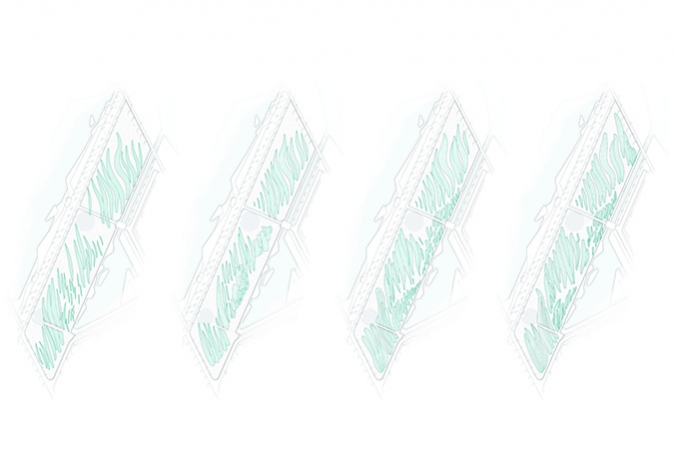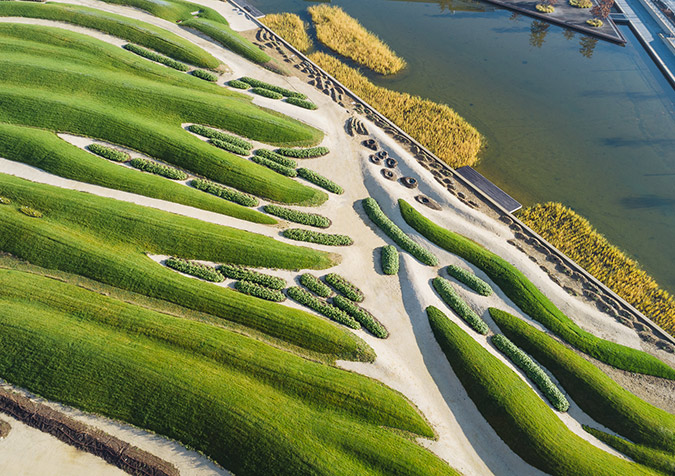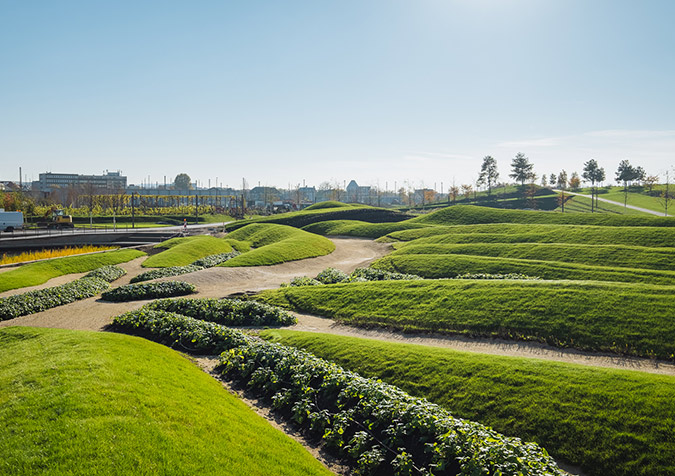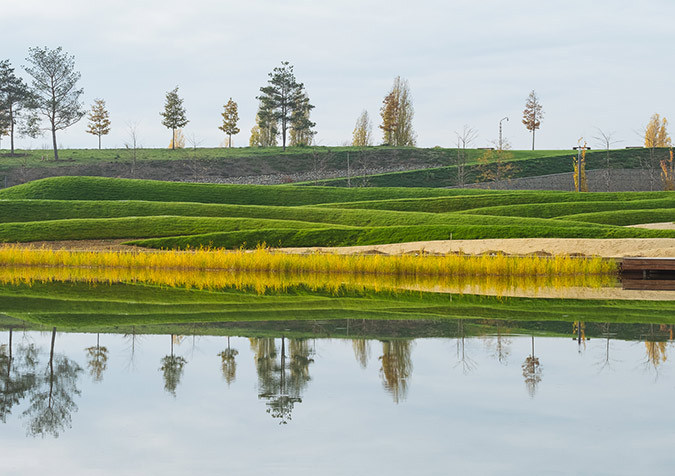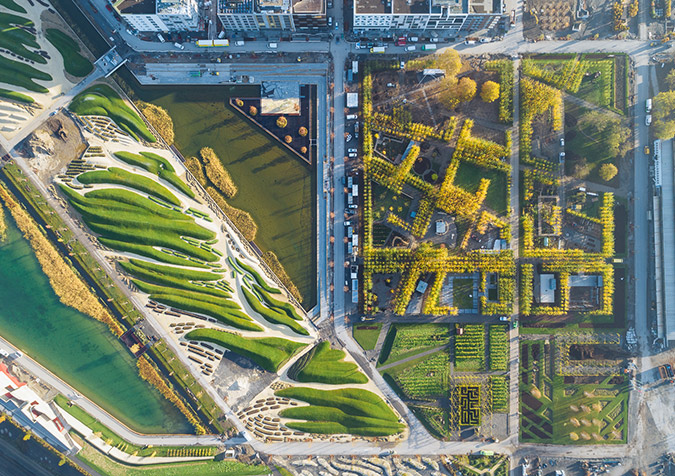Summer Island, BUGA 2019
The undulating landscape from the data matrix, 2016-2019, Heilbronn
Planungspartner:
Riehl Bauermann + Partner (LP: 6-8)
On the summer island in Heilbronn, one of the first 3D-generated landscape parks, combining the shapes of moraines, dunes and sandy beaches, opens with the Federal Horticultural Show (“Bundesgartenschau”, BUGA in short) 2019. On the summer island in Heilbronn, one of the world’s first digitally-designed and -built landscape parks has been created for the BUGA 2019. On a plot of about 70 by 500 meters and shaped as a parallelogram, organically shaped landscape-waves join up diagonally at an angle to form a sandy landscape with natural shapes of dunes, moraines and the ephemeral patterns of a sandy landscape. The model of the 3D-generated landscape – shaped according to the rules of nature – was created as a data matrix in the architect’s office LOMA in Kassel at the desk of the landscape architect and urban planner Wolfgang Schück with the help of his partner Ilija Vukorep, a professor of Digital Design Methods at the BTU in Cottbus. The undulating landscape on the summer island will open to the public with the BUGA’s opening on 17th April 2019, but – being a temporary staging – it will fade away with the end of summer. „A big door opened.“ The site of today’s BUGA area with the summer island, situated between the canalized Neckar river and one of the river’s branches, used to house wet docks as well as industrial and railway facilities. Later, the docks were filled and the switchyard disappeared. Meanwhile, the docks have been partially reopened, were re-connected to the Neckar’s branch and filled up with water again. The summer island itself lies between two former wet docks, which today carry the names Stadtsee and Karlsee. After the BUGA, there are plans for housing developments with an open block structure at the site. The design for the master plan was done by the Berlin landscape architects Sinai. LOMA was commissioned in 2016 with the temporary design of the summer island. "I was asked to think of something regarding the summer island," says Schück, "and at the BUGA there was a new, young project manager who asked me: what do you actually want? That"s when I realized that there was a big door opening up.” Because the architect and planner isn’t always granted such freedom. At the beginning, there was a „zero-place“ At that time the summer island was covered with large piles of soil. Excavators, large trucks and tipping lorries had piled up huge depots of the river Neckar’s clayey alluvial soil here – a material more suited to creating a lunar landscape than a base for a horticultural show. The construction site had nothing in common with the dream of a summer island. Schück speaks of a “zero-place”. That is why in his imagination Schück walked along a beach visualizing himself on a summer island. He discovered the sand, which had been left damp and firm in curly shapes by the outflowing waves, only to grow in size with each new wave surging in, then gently being eroded again as it flowed back. „How does landscape generate (itself)?“ Schück, who comes from Salzburg, had, however, also been thinking of his homeland and the Alpine foothills with their glacier-shaped, gently undulating moraine landscape. “What do wind and water, sliding glaciers and melting ice do to the kind of soil that builds up at the Neckar over the years?” Schück asked himself. “How does landscape generate itself? How do we find out in what way nature acts as a landscaper? These questions appealed to me”, Schück tells and continues: “How is it possible to recreate the natural wave formation in the soil which forms ripples with a generative design?” Schück studied early drawings of natural science from the 17th century, in which cartographers had tried to trace the Upper Bavarian moraine landscape. He, too, tried to sketch the lines of the sandy beach on paper, "but that just looked like a botched attempt to copy God, because you just cannot do it like him". 3D-software from boat building shapes the new landscape Schück then turned to his own office’s parametrization department and found a solution with his partner Vukorep: The architects entered drawings of moraines, dunes and sand waves into the computer using Rhino 3D, a special software. It was the boat industry that first used this software to construct dynamically optimized hulls. Then the automobile industry discovered the software to design cars in a more organic, a more flowing form which customers apparently consider beautiful. According to architect Petra Brunnhofer, also a partner in the LOMA office, the tool is rarely used in architecture, however, and even less often in the field of landscape architecture, due to basic conservatism. At the same time, the concept of creating landscape parks by modeling after nature is not new. Before planting the park Wilhelmsthal near Kassel, a Rococo facility, the Landgrave’s gardeners are said to have studied the moraine landscapes of Upper Bavaria, in order to form the park’s hills as skillfully as they did. A park in a data cloud About 300 years later, Schück resorted to modern means of achieving an organic result in the contemporary creation of a landscaped park. According to the rules set by nature, the LOMA team had the computer transform the existing and variously piled up soil into a moraine, dune and sand landscape with the aid of the 3D software. In the end, Schück had no two-dimensional plan but a cloud with millions of data points in virtual, three-dimensional space. In order to transform these into reality, Prof. Wigbert Riehl, Chair of Landscape Architecture and Technology at the University of Kassel, proved to be a congenial partner. Already during the construction of the landscape park Duisburg-Nord, Riehl made a name for himself with his approaches to experimental construction, and by 2007 Riehl and Schück had introduced the parametric methods for the first time to the studies of landscape architecture in Europe. A summer island like landscape sampling Tablets and GPS controls were installed in the heavy excavators used on the Summer Island and the machines’ drivers rebuilt the virtual landscape most realistically. "That was new. Because developing complex landscapes in this way had never been done before, for technical reasons. Excavators in landscaping, as opposed to machines in agriculture, are still very analog" says Schück. “Everything was generated by the drivers out of the data matrix." Where the big 25 ton excavators could not model the intricacies of the landscape, a smaller excavator was used. A subbase and rolled sod were applied to the undulating landscape. It now resembles the Alpine foothills. In between, there are sandy passages reminiscent of dunes. Schück speaks of a picture puzzle of green moraines and sandy dunes. The lawns are irrigated with water from the Neckar, and the sandy soils are planted with summer flowers and wild herbs that tolerate heat and UV rays, as they occur at the seaside or on high mountains. Even an own robot lawnmower was developed for the landscape park from the data matrix. Its rotary mower is not situated at the front, as is usually the case, but underneath, while chains instead of wheels allow for remarkable cross-country mobility. A walk-through sculpture with a massive degree of freedom The result is a landscaped park, a walk-in sculpture, which offers a semi-natural staging as in the Baroque period or later the English garden but in democratic times. The landscape is not aimed at any ruler. "There is neither an entrance nor an exit, no paths and no park benches. As well as moraine, dunes and sand there are flat areas and hills to climb, a green sea of waves to sunbathe or joyfully roll around. It is a dream-like structure that brings North and South together. Prussia meets Habsburg, the landscape architect from the Alps meets the Berlin surveyors. The mocking words and nicknames that my landscape park evokes show how unusual it is. This landscape allows a massive degree of freedom," says Schück who is thrilled with the forms that remain as a data matrix when soon houses will be built on the Neckar bank. But, perhaps, the viewer thinks, they could also stand on stilts, so that landscape waves continue to keep silence underneath them. text: Claus Müller von der Grün
Riehl Bauermann + Partner (LP: 6-8)
On the summer island in Heilbronn, one of the first 3D-generated landscape parks, combining the shapes of moraines, dunes and sandy beaches, opens with the Federal Horticultural Show (“Bundesgartenschau”, BUGA in short) 2019. On the summer island in Heilbronn, one of the world’s first digitally-designed and -built landscape parks has been created for the BUGA 2019. On a plot of about 70 by 500 meters and shaped as a parallelogram, organically shaped landscape-waves join up diagonally at an angle to form a sandy landscape with natural shapes of dunes, moraines and the ephemeral patterns of a sandy landscape. The model of the 3D-generated landscape – shaped according to the rules of nature – was created as a data matrix in the architect’s office LOMA in Kassel at the desk of the landscape architect and urban planner Wolfgang Schück with the help of his partner Ilija Vukorep, a professor of Digital Design Methods at the BTU in Cottbus. The undulating landscape on the summer island will open to the public with the BUGA’s opening on 17th April 2019, but – being a temporary staging – it will fade away with the end of summer. „A big door opened.“ The site of today’s BUGA area with the summer island, situated between the canalized Neckar river and one of the river’s branches, used to house wet docks as well as industrial and railway facilities. Later, the docks were filled and the switchyard disappeared. Meanwhile, the docks have been partially reopened, were re-connected to the Neckar’s branch and filled up with water again. The summer island itself lies between two former wet docks, which today carry the names Stadtsee and Karlsee. After the BUGA, there are plans for housing developments with an open block structure at the site. The design for the master plan was done by the Berlin landscape architects Sinai. LOMA was commissioned in 2016 with the temporary design of the summer island. "I was asked to think of something regarding the summer island," says Schück, "and at the BUGA there was a new, young project manager who asked me: what do you actually want? That"s when I realized that there was a big door opening up.” Because the architect and planner isn’t always granted such freedom. At the beginning, there was a „zero-place“ At that time the summer island was covered with large piles of soil. Excavators, large trucks and tipping lorries had piled up huge depots of the river Neckar’s clayey alluvial soil here – a material more suited to creating a lunar landscape than a base for a horticultural show. The construction site had nothing in common with the dream of a summer island. Schück speaks of a “zero-place”. That is why in his imagination Schück walked along a beach visualizing himself on a summer island. He discovered the sand, which had been left damp and firm in curly shapes by the outflowing waves, only to grow in size with each new wave surging in, then gently being eroded again as it flowed back. „How does landscape generate (itself)?“ Schück, who comes from Salzburg, had, however, also been thinking of his homeland and the Alpine foothills with their glacier-shaped, gently undulating moraine landscape. “What do wind and water, sliding glaciers and melting ice do to the kind of soil that builds up at the Neckar over the years?” Schück asked himself. “How does landscape generate itself? How do we find out in what way nature acts as a landscaper? These questions appealed to me”, Schück tells and continues: “How is it possible to recreate the natural wave formation in the soil which forms ripples with a generative design?” Schück studied early drawings of natural science from the 17th century, in which cartographers had tried to trace the Upper Bavarian moraine landscape. He, too, tried to sketch the lines of the sandy beach on paper, "but that just looked like a botched attempt to copy God, because you just cannot do it like him". 3D-software from boat building shapes the new landscape Schück then turned to his own office’s parametrization department and found a solution with his partner Vukorep: The architects entered drawings of moraines, dunes and sand waves into the computer using Rhino 3D, a special software. It was the boat industry that first used this software to construct dynamically optimized hulls. Then the automobile industry discovered the software to design cars in a more organic, a more flowing form which customers apparently consider beautiful. According to architect Petra Brunnhofer, also a partner in the LOMA office, the tool is rarely used in architecture, however, and even less often in the field of landscape architecture, due to basic conservatism. At the same time, the concept of creating landscape parks by modeling after nature is not new. Before planting the park Wilhelmsthal near Kassel, a Rococo facility, the Landgrave’s gardeners are said to have studied the moraine landscapes of Upper Bavaria, in order to form the park’s hills as skillfully as they did. A park in a data cloud About 300 years later, Schück resorted to modern means of achieving an organic result in the contemporary creation of a landscaped park. According to the rules set by nature, the LOMA team had the computer transform the existing and variously piled up soil into a moraine, dune and sand landscape with the aid of the 3D software. In the end, Schück had no two-dimensional plan but a cloud with millions of data points in virtual, three-dimensional space. In order to transform these into reality, Prof. Wigbert Riehl, Chair of Landscape Architecture and Technology at the University of Kassel, proved to be a congenial partner. Already during the construction of the landscape park Duisburg-Nord, Riehl made a name for himself with his approaches to experimental construction, and by 2007 Riehl and Schück had introduced the parametric methods for the first time to the studies of landscape architecture in Europe. A summer island like landscape sampling Tablets and GPS controls were installed in the heavy excavators used on the Summer Island and the machines’ drivers rebuilt the virtual landscape most realistically. "That was new. Because developing complex landscapes in this way had never been done before, for technical reasons. Excavators in landscaping, as opposed to machines in agriculture, are still very analog" says Schück. “Everything was generated by the drivers out of the data matrix." Where the big 25 ton excavators could not model the intricacies of the landscape, a smaller excavator was used. A subbase and rolled sod were applied to the undulating landscape. It now resembles the Alpine foothills. In between, there are sandy passages reminiscent of dunes. Schück speaks of a picture puzzle of green moraines and sandy dunes. The lawns are irrigated with water from the Neckar, and the sandy soils are planted with summer flowers and wild herbs that tolerate heat and UV rays, as they occur at the seaside or on high mountains. Even an own robot lawnmower was developed for the landscape park from the data matrix. Its rotary mower is not situated at the front, as is usually the case, but underneath, while chains instead of wheels allow for remarkable cross-country mobility. A walk-through sculpture with a massive degree of freedom The result is a landscaped park, a walk-in sculpture, which offers a semi-natural staging as in the Baroque period or later the English garden but in democratic times. The landscape is not aimed at any ruler. "There is neither an entrance nor an exit, no paths and no park benches. As well as moraine, dunes and sand there are flat areas and hills to climb, a green sea of waves to sunbathe or joyfully roll around. It is a dream-like structure that brings North and South together. Prussia meets Habsburg, the landscape architect from the Alps meets the Berlin surveyors. The mocking words and nicknames that my landscape park evokes show how unusual it is. This landscape allows a massive degree of freedom," says Schück who is thrilled with the forms that remain as a data matrix when soon houses will be built on the Neckar bank. But, perhaps, the viewer thinks, they could also stand on stilts, so that landscape waves continue to keep silence underneath them. text: Claus Müller von der Grün
